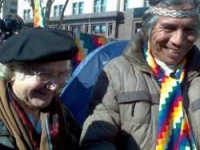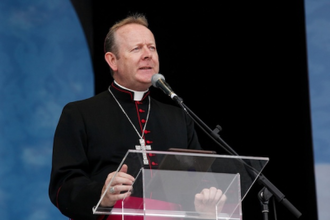Holy Father receives Argentinan indigenous leader

Adolfo Esquivel with Félix Díaz
This morning (Monday) Pope Francis received in audience Mr Adolfo Pérez Esquivel, a human rights campaigner Nobel Peace Laureate, his wife Amanda Asijak, and Mr Félix Díaz, an indigenous Argentinian from the ethnic Qom people, who live in the 'Spring' community in Formosa, Argentina. They were accompanied by Rev Francisco Nazar, Episcopal Vicar for the indigenous populations of the Diocese of Formosa.
Díaz expressed his gratitude to the Holy Father for the audience and as an expression of his interest and support. The ethnic leader also spoke of the difficulties that the indigenous peoples of Argentina and Latin America suffer, as well as their concerns for the protection of their rights, particularly with regard to their territory and cultural identity.
The Qom (also known as Toba) are an ethnic group in Argentina, Bolivia and Paraguay. They are part of a larger group of indigenous inhabitants of the Gran Chaco region, called the Guaycurues. As of 2005, there are 47,951 Qom in Argentina, living in the provinces of Chaco, Formosa and Santa Fe.
The Chaco region in the north of Argentina and part of Paraguay was formerly covered with forests. The Qom were originally nomadic hunter-gatherers who, upon the arrival of the Spanish, adopted the horse and resisted colonial encroachment and missionization for several centuries.
In the 1880s the Argentine government began a campaign to occupy new territories, defeating the last organized attempts by the Toba to defend their lands. The Argentine Chaco was divided up in large portions and exploited, especially for the valuable quebracho tree, used for its tannin and its extremely durable timber. This devastated the ecosystem in a relatively short time. The private owners of the Chaco then turned to cotton production, employing the Toba as a cheap seasonal workforce; the conditions did not change substantially for decades.
On 19 July 19, 1924 in Napalpí in the Chaco Province of Northern Argentina 200 Qoms were massacred by the Argentine Police and ranchers.
Beginning in 1982, the region suffered unprecedented floods, which caused the crops to be ruined; and in the 1990s, mechanical harvesters imported from Brazil (at very low prices due to Argentina's low fixed exchange rate) left many Qoms without jobs. The provincial government of Chaco resorted to giving one-way tickets to the Qoms willing to migrate south, into Santa Fe.
The majority of these migrants settled in Rosario, a large city in the south of Santa Fe province and had seen a previous wave of Qoms in the 1950s and 1960s.
An estimated 10,000 Qoms came to Rosario in the 1990s, and settled mostly in slums.
Source: VIS/ICN















